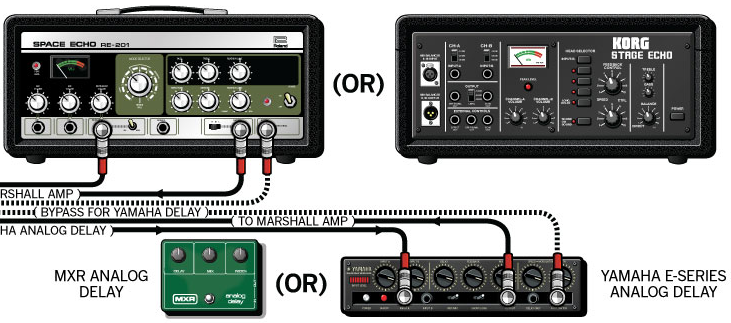Guitargeek - Guitar Signal Chain Examples
Guitargeek.com is, as its name suggests, one of the geekier sites on the internet with respect to documenting rock artists and what they do to get their sound. The archive claims to go back to 1993, when the author and originator, Adam Cooper, began the project. Unfortunately, as I recall there used to be a lot more information up on Guitargeek.com. It appears that despite logging material since 1993, the site only goes back a little over a year, to December (a few times, I've seen a few August, but not reliably) 2013. I remember it used to have Tony Iommi, and many many other players. A lot seems to have vanished. Whether this was a DB corruption, or something else we don't know. We did attempt to check the cause, but there is none posted.
As an exercise in knowing the trivia about an artist and his/her gear, Guitargeek.com provides some interesting fodder. However, where this can get a lot more interesting is if you're (presumably) an artist that is working on your sound. The part where this really gets interesting is understanding how your favorite artists created their sound. As we say in the Thermionic Studios Wiki, that every great artist got to where they are now by attempting to walk the path of their own heroes. It makes sense that you should do the same. The only difference is in when you decide to be your own artist. Do you want to dwell in the sound space that your heroes created? Or do you want to sound like yourself and have people so love what you've done that they, in turn, wish to sound like you?
Have you found out on your own how to replicate a particular artist's sound? We have, for sure. And in fact, I have a perfect example for you. For a long time, many players wondered how Eddie Van Halen got that phaser sound in "Eruption". It's a phaser that's not only warbling in and out, like a phaser does, but it's also swelling in and out, not like a phaser does. Eddie did it by putting his MXR Phase 90 between his guitar and his amp. You'd never know it, unless you've done in-depth research, but Eddie Van Halen ended up using his 1968 Marshall Super Lead not as much as an amp, but after his mods, and hooking in a variac and lowering the voltage from the wall, the amplifier ends up acting more like a distortion pedal. Unlike most players who learn at low volumes and put the phaser after the distortion pedal (because it sounds the cleanest this way), Eddie put it before, because his amp was an amp, and not a pedal...
You should be able to find out all kinds of cool stuff like this by looking at the signal chain of your favorite artists.

